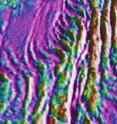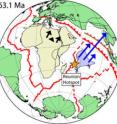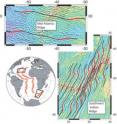Scripps researchers discover new force driving Earth's tectonic plates
Related images
(click to enlarge)
Bringing fresh insight into long-standing debates about how powerful geological forces shape the planet, from earthquake ruptures to mountain formations, scientists at Scripps Institution of Oceanography at UC San Diego have identified a new mechanism driving Earth's massive tectonic plates. Scientists who study tectonic motions have known for decades that the ongoing "pull" and "push" movements of the plates are responsible for sculpting continental features around the planet. Volcanoes, for example, are generally located at areas where plates are moving apart or coming together. Scripps scientists Steve Cande and Dave Stegman have now discovered a new force that drives plate tectonics: Plumes of hot magma pushing up from Earth's deep interior. Their research is published in the July 7 issue of the journal Nature.
Using analytical methods to track plate motions through Earth's history, Cande and Stegman's research provides evidence that such mantle plume "hot spots," which can last for tens of millions of years and are active today at locations such as Hawaii, Iceland and the Galapagos, may work as an additional tectonic driver, along with push-pull forces.
Their new results describe a clear connection between the arrival of a powerful mantle plume head around 70 million years ago and the rapid motion of the Indian plate that was pushed as a consequence of overlying the plume's location. The arrival of the plume also created immense formations of volcanic rock now called the "Deccan flood basalts" in western India, which erupted just prior to the mass extinction of dinosaurs. The Indian continent has since drifted north and collided with Asia, but the original location of the plume's arrival has remained volcanically active to this day, most recently having formed Réunion island near Madagascar.
The team also recognized that this "plume-push" force acted on other tectonic plates, and pushed on Africa as well but in the opposite direction.
"Prior to the plume's arrival, the African plate was slowly drifting but then stops altogether, at the same time the Indian speeds up," explains Stegman, an assistant professor of geophysics in Scripps' Cecil H. and Ida M. Green Institute of Geophysics and Planetary Physics. "It became clear the motion of the Indian and African plates were synchronized and the Réunion hotspot was the common link."
After the force of the plume had waned, the African plate's motion gradually returned to its previous speed while India slowed down.
"There is a dramatic slow down in the northwards motion of the Indian plate around 50 million years ago that has long been attributed to the initial collision of India with the Eurasian plate," said Cande, a professor of marine geophysics in the Geosciences Research Division at Scripps. "An implication of our study is that the slow down might just reflect the waning of the mantle plume-the actual collision might have occurred a little later."
Source: University of California - San Diego
Other sources
- Deep magma tagged as tectonic factorfrom UPISat, 9 Jul 2011, 0:00:31 UTC
- Deep magma tagged as tectonic factorfrom UPIFri, 8 Jul 2011, 1:00:28 UTC
- New force driving Earth's tectonic platesfrom Science DailyWed, 6 Jul 2011, 18:31:07 UTC
- New force driving Earth's tectonic plates discoveredfrom PhysorgWed, 6 Jul 2011, 17:00:53 UTC


